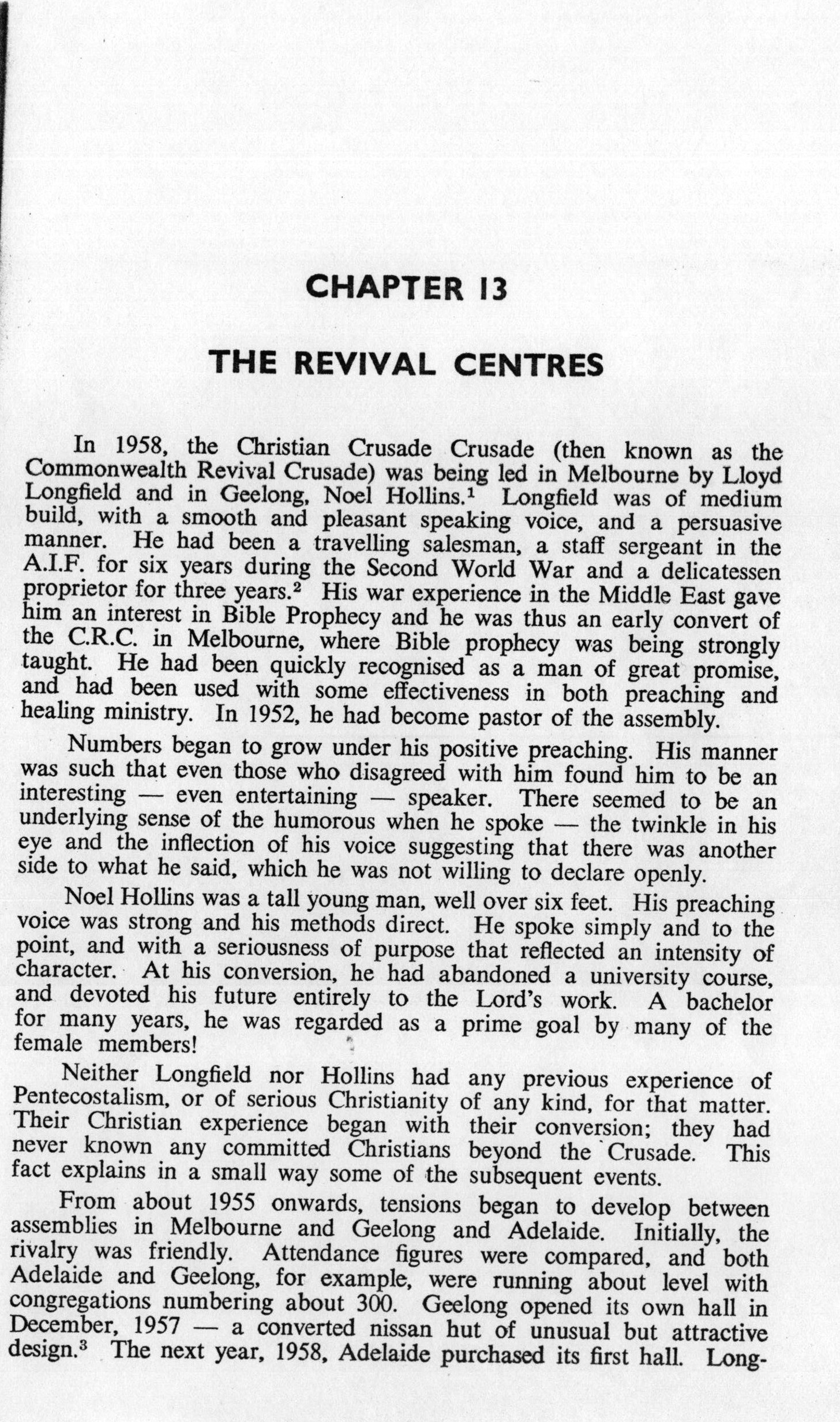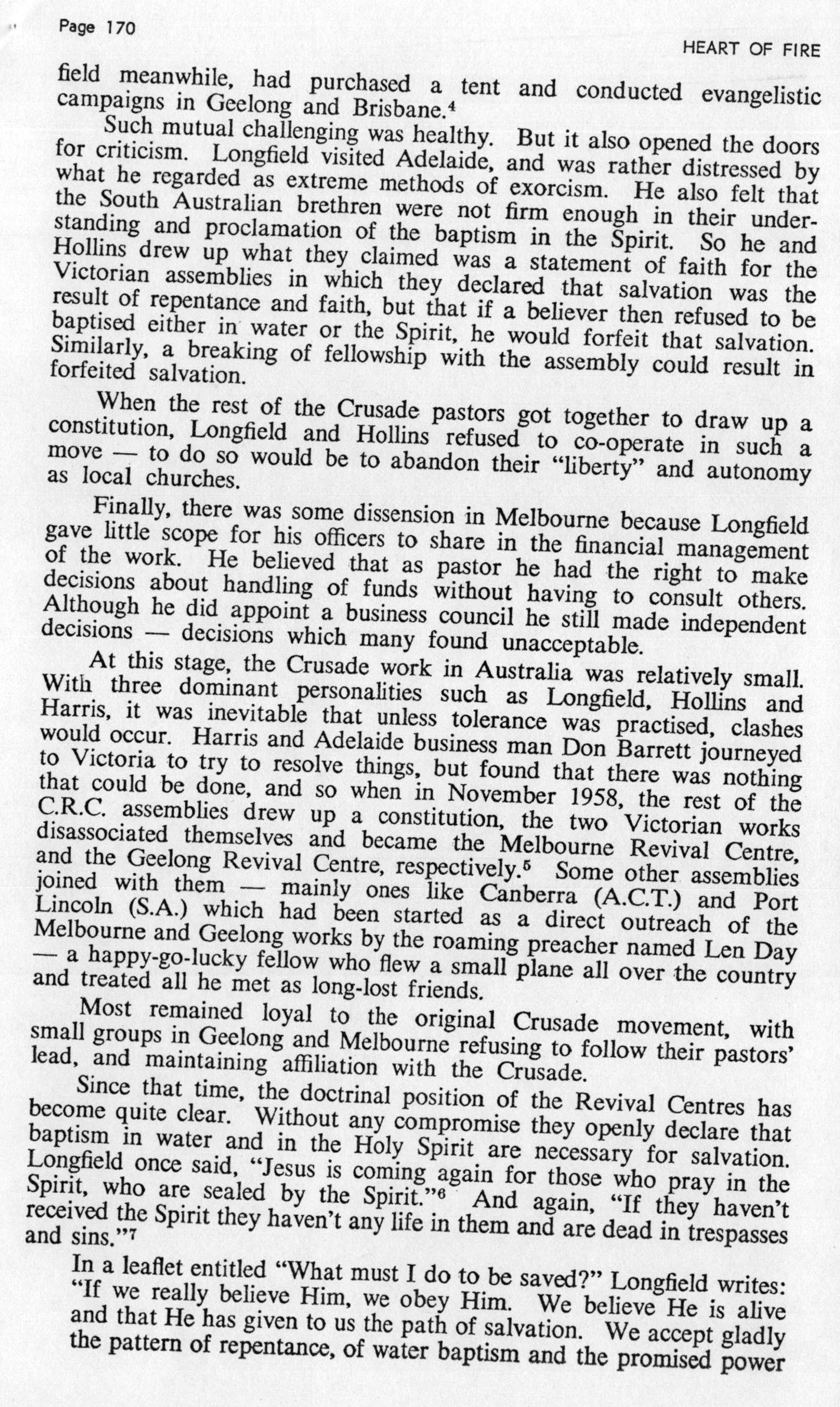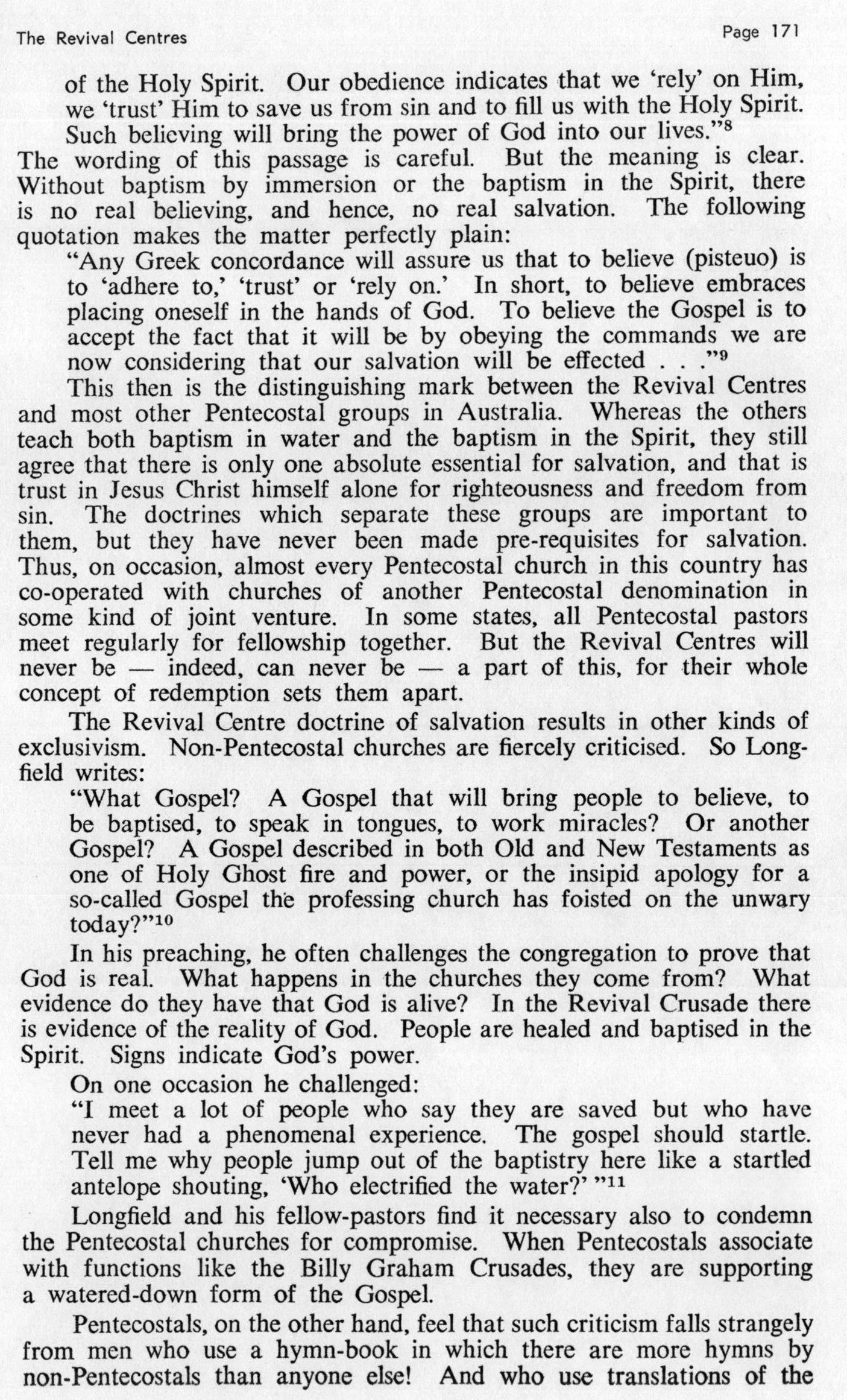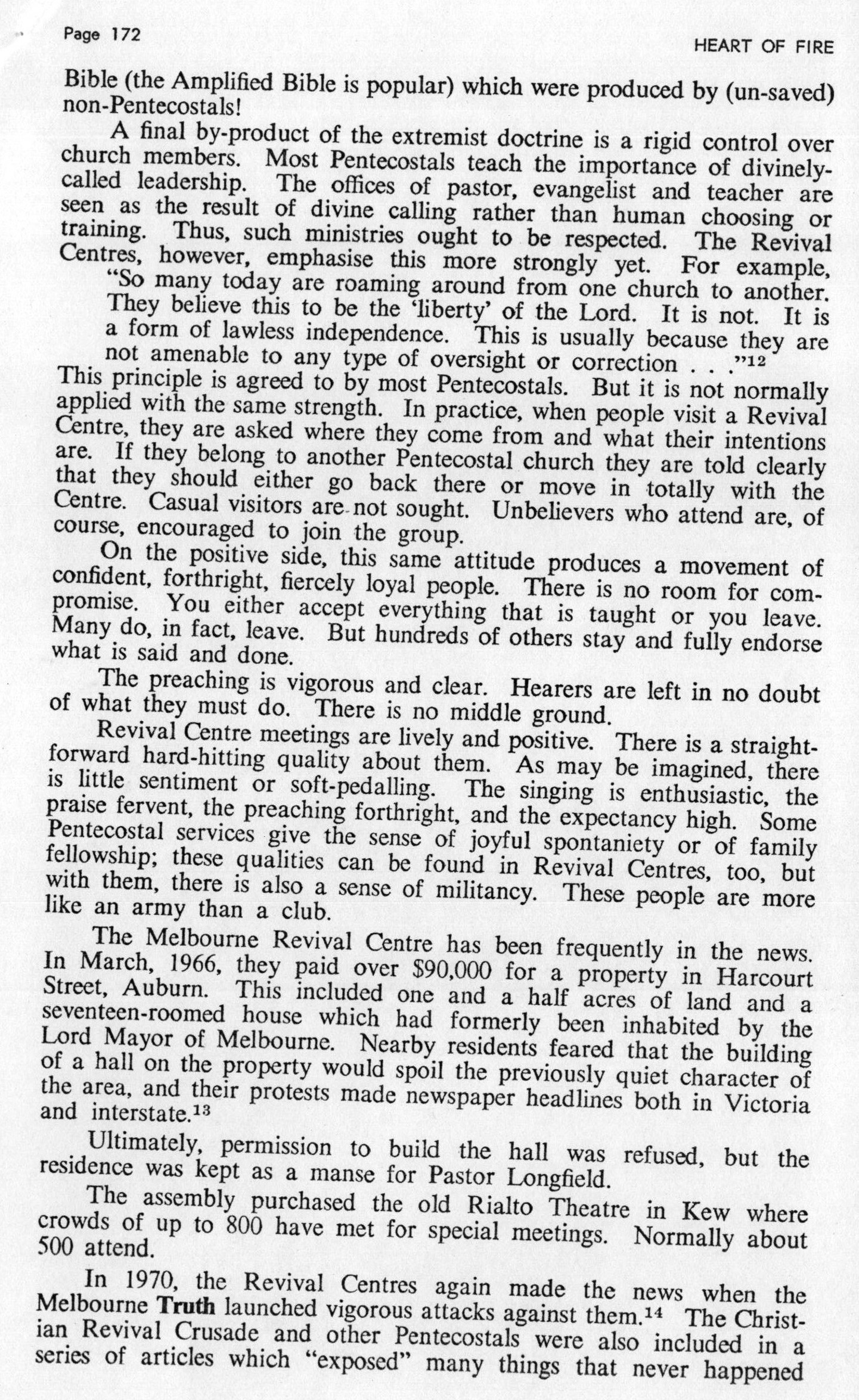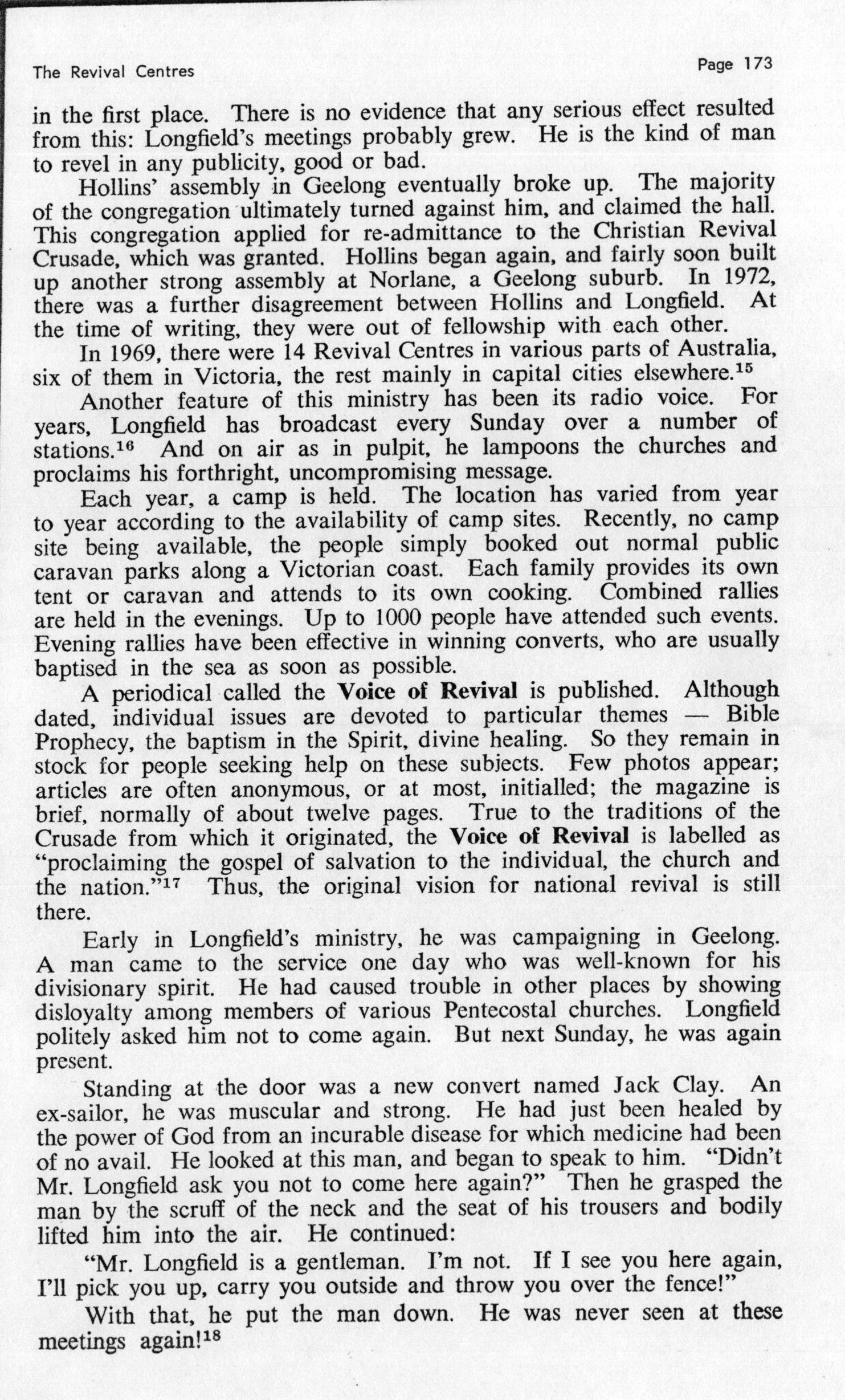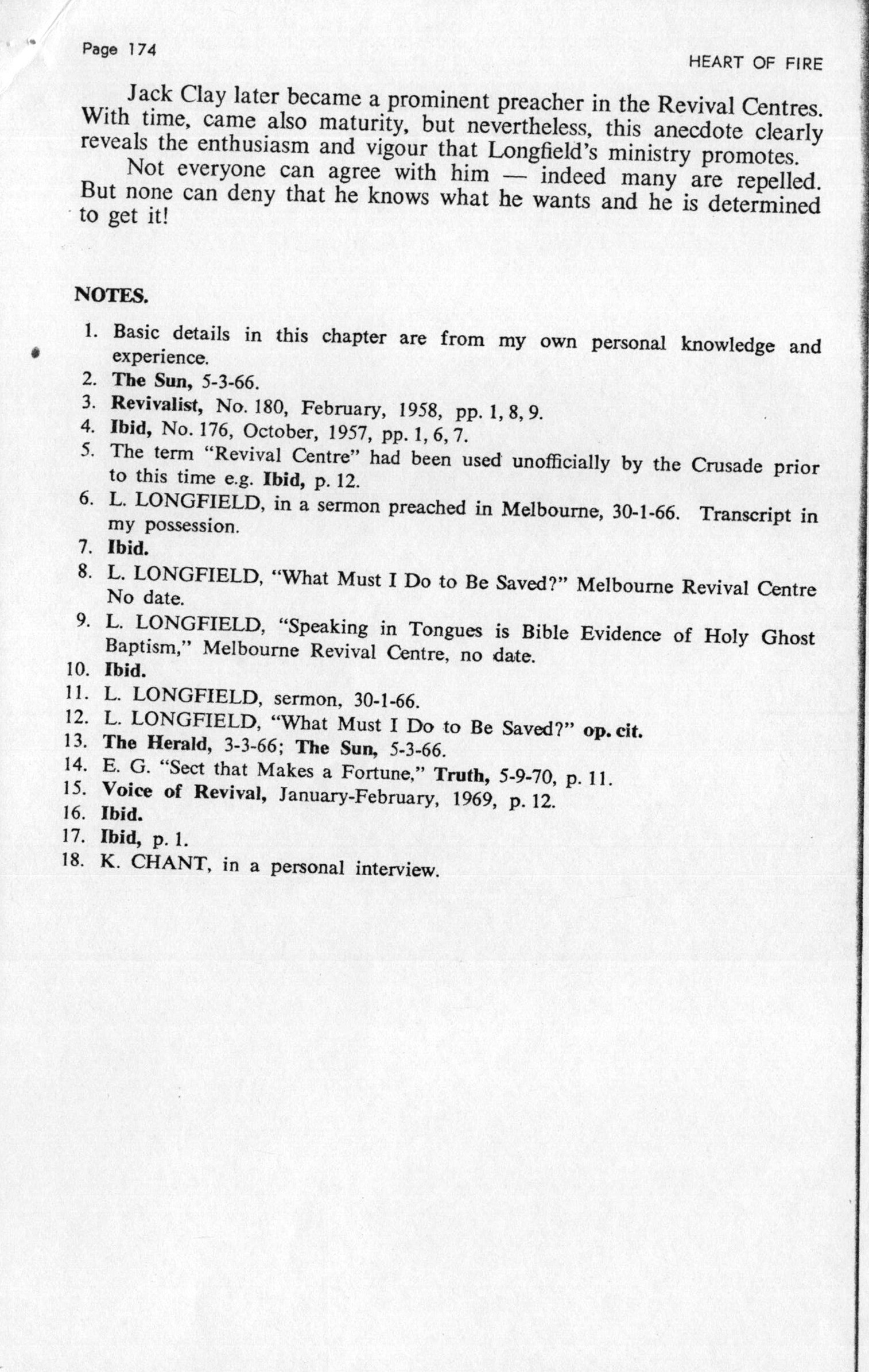
|
| Title: 1959 to 1989 - 'The Revival Centres' by Barry Chant | |
| Revival_Centres_Discussion_Forums > Revival Churches > Revival churches History | Go to subcategory: |
| Author | Content |
|
Ex_Member
|
|
|
Date Posted:31/03/2010 8:08 AMCopy HTML The Revival CentresBy Barry Chant Taken from his book Heart of Fire. In 1958, the Christian Revival Crusade (then known as the Commonwealth Revival Crusade) was being led in Melbourne by Lloyd Longfield and in Geelong, Noel Hollins. Longfield was of medium build, with a smooth and pleasant speaking voice, and a persuasive manner. He had been a travelling salesman, a staff sergeant in the A.I.F. for six years during the Second World War and a delicatessen proprietor for three years. His war experience in the Middle East gave him an interest in Bible Prophecy and he was thus an early convert of the C.R.C. in Melbourne, where Bible prophecy was being strongly taught. He had been quickly recognised as a man of great promise, and had been used with some effectiveness in both preaching and healing ministry. In 1952, he had become pastor of the assembly. Numbers began to grow under his positive preaching. His manner was such that even those who disagreed with him found him to be an interesting - even entertaining - speaker. There seemed to be an underlying sense of the humorous when he spoke - the twinkle in his eye and the inflection of his voice suggesting that there was another side to what he said, which he was not willing to declare openly. Noel Hollins was a tall young man, well over six feet. His preaching voice was strong and his methods direct. He spoke simply and to the point, and with a seriousness of purpose that reflected an intensity of character. At his conversion, he had abandoned a university course, and devoted his future entirely to the Lord's work. A bachelor for many years, he was regarded as a prime goal by many of the female members! Neither Longfield nor Hollins had any previous experience of Pentecostalism, or of serious Christianity of any kind, for that matter. Their Christian experience began with their conversion; they had never known any committed Christians beyond the Crusade. This fact explains in a small way some of the subsequent events. From about 1955 onwards, tensions began to develop between assemblies in Melbourne and Geelong and Adelaide. Initially, the rivalry was friendly. Attendance figures were compared, and both Adelaide and Geelong, for example, were running about level with congregations numbering about 300. Geelong opened its own hall in December, 1957 - a converted nissan hut of unusual but attractive design. The next year, 1958, Adelaide purchased its first hall. Longfield meanwhile, had purchased a tent and conducted evangelistic campaigns in Geelong and Brisbane. Such mutual challenging was healthy. But it also opened the doors for criticism. Longfield visited Adelaide, and was rather distressed by what he regarded as extreme methods of exorcism. He also felt that the South Australian brethren were not firm enough in their under- standing and proclamation of the baptism in the Spirit. So he and Hollins drew up what they claimed was a statement of faith for the Victorian assemblies in which they declared that salvation was the result of repentance and faith, but that if a believer then refused to be baptised either in water or the Spirit, he would forfeit that salvation. Similarly, a breaking of fellowship with the assembly could result in forfeited salvation. When the rest of the Crusade pastors got together to draw up a constitution, Longfield and Hollins refused to co-operate in such a move - to do so would be to abandon their "liberty" and autonomy as local churches. Finally, there was some dissension in Melbourne because Longfield gave little scope for his officers to share in the financial management of the work. He believed that as pastor he had the right to make decisions about handling of funds without having to consult others. Although he did appoint a business council he still made independent decisions - decisions which many found unacceptable. At this stage, the Crusade work in Australia was relatively small. With three dominant personalities such as Longfield, Hollins and Harris, it was inevitable that unless tolerance was practised, clashes would occur. Harris and Adelaide business man Don Barrett journeyed to Victoria to try to resolve things, but found that there was nothing that could be done, and so when in November 1958, the rest of the C.R.C. assemblies drew up a constitution, the two Victorian works disassociated themselves and became the Melbourne Revival Centre, and the Geelong Revival Centre, respectively. Some other assemblies joined with them - mainly ones like Canberra (A.C.T.) and Port Lincoln (S.A.) which had been started as a direct outreach of the Melbourne and Geelong works by the roaming preacher named Len Day - a happy-go-lucky fellow who flew a small plane all over the country and treated all he met as long-lost friends. Most remained loyal to the original Crusade movement, with small groups in Geelong and Melbourne refusing to follow their pastors' lead, and maintaining affiliation with the Crusade. Since that time, the doctrinal position of the Revival Centres has become quite clear. Without any compromise they openly declare that baptism in water and in the Holy Spirit are necessary for salvation. Longfield once said. "Jesus is coming again for those who pray in the Spirit, who are sealed by the Spirit." And again, "If they received the Spirit they haven't any life in them and are dead in trespasses and sins". In a leaflet entitled "What must I do to be saved?" Longfield writes: "If we really believe Him, we obey Him. We believe He is alive and that He has given to us the path of salvation. We accept gladly the pattern of repentance, of water baptism and the promised power of the Holy Spirit. Our obedience indicates that we 'rely' on Him, we 'trust' Him to save us from sin and to fill us with the Holy Spirit. Such believing will bring the power of God into our lives." The wording of this passage is careful. But the meaning is clear. Without baptism by immersion or the baptism in the Spirit, there is no real believing, and hence, no real salvation. The following quotation makes the matter perfectly plain: "Any Greek concordance will assure us that to believe (pisteuo) is to 'adhere to,' 'trust' or 'rely on.' In short, to believe embraces placing oneself in the hands of God. To believe the Gospel is to accept the fact that it will be by obeying the commands we are now considering that our salvation will be effected..." This then is the distinguishing mark between the Revival Centres and most other Pentecostal groups in Australia. Whereas the others teach both baptism in water and the baptism in the Spirit, they still agree that there is only one absolute essential for salvation, and that is trust in Jesus Christ himself alone for righteousness and freedom from sin. The doctrines which separate these groups are important to them, but they have never been made pre-requisites for salvation. Thus, on occasion, almost every Pentecostal church in this country has co-operated with churches of another Pentecostal denomination in some kind of joint venture. In some states, all Pentecostal pastors meet regularly for fellowship together. But the Revival Centres will never be - indeed, can never be - a part of this, for their whole concept of redemption sets them apart. The Revival Centre doctrine of salvation results in other kinds of exclusivism. Non-Pentecostal churches are fiercely criticised. So Longfield writes: "What Gospel? A Gospel that will bring people to believe, to be baptised, to speak in tongues, to work miracles? Or another Gospel? A Gospel described in both Old and New Testaments as one of Holy Ghost fire and power, or the insipid apology for a so-called Gospel the professing church has foisted on the unwary today?" In his preaching, he often challenges the congregation to prove that God is real. What happens in the churches they come from? What evidence do they have that God is alive? In the Revival Crusade there is evidence of the reality of God. People are healed and baptised in the Spirit. Signs indicate God's power. On one occasion he challenged: "I meet a lot of people who say they are saved but who have never had a phenomenal experience. The gospel should startle. Tell me why people jump out of the baptistry here like a startled antelope shouting, 'Who electrified the water?'" Longfield and his fellow-pastors find it necessary also to condemn the Pentecostal churches for compromise. When Pentecostals associate with functions like the Billy Graham Crusades, they are supporting a watered-down form of the Gospel. Pentecostals, on the other hand, feel that such criticism falls strangely from men who use a hymn-book in which there are more hymns by non-Pentecostals than anyone else! And who use translations of the Bible (the Amplified Bible is popular) which were produced by (un-saved) non-Pentecostals! A final by-product of the extremist doctrine is a rigid control over church members. Most Pentecostals teach the importance of divinely- called leadership. The offices of pastor, evangelist and teacher are seen as the result of divine calling rather than human choosing or training. Thus, such ministries ought to be respected. The Revival Centres, however, emphasise this more strongly yet. For example, "So many today are roaming around from one church to another. They believe this to be the 'liberty' of the Lord. It is not. It is a form of lawless independence. This is usually because they are not amenable to any type of oversight or correction..." This principle is agreed to by most Pentecostals. But it is not normally applied with the same strength. In practice, when people visit a Revival Centre, they are asked where they come from and what their intentions are. If they belong to another Pentecostal church they are told clearly that they should either go back there or move in totally with the Centre. Casual visitors are not sought. Unbelievers who attend are, of course, encouraged to join the group. On the positive side, this same attitude produces a movement of confident, forthright, fiercely loyal people. There is no room for compromise. You either accept everything that is taught or you leave. Many do, in fact, leave. But hundreds of others stay and fully endorse what is said and done. The preaching is vigorous and clear. Hearers are left in no doubt of what they must do. There is no middle ground. Revival Centre meetings are lively and positive. There is a straight- forward hard-hitting quality about them. As may be imagined, there is little sentiment or soft-pedalling. The singing is enthusiastic, the praise fervent, the preaching forthright, and the expectancy high. Some Pentecostal services give the sense of joyful spontaniety or of family fellowship; these qualities can be found in Revival Centres, too, but with them, there is also a sense of militancy. These people are more like an army than a club. The Melbourne Revival Centre has been frequently in the news. In March, 1966, they paid over $90,000 for a property in Harcourt Street, Auburn. This included one and a half acres of land and a seventeen-roomed house which had formerly been inhabited by the Lord Mayor of Melbourne. Nearby residents feared that the building of a hall on the property would spoil the previously quiet character of the area, and their protests made newspaper headlines both in Victoria and interstate. Ultimately, permission to build the hall was refused, but the residence was kept as a manse for Pastor Longfield. The assembly purchased the old Rialto Theatre in Kew where crowds of up to 800 have met for special meetings. Normally about 500 attend. In 1970, the Revival Centres again made the news when the Melbourne Truth launched vigorous attacks against them. The Christian Revival Crusade and other Pentecostals were also included in a series of articles which "exposed" many things that never happened in the first place. There is no evidence that any serious effect resulted from this: Longfield's meetings probably grew. He is the kind of man to revel in any publicity, good or bad. Hollins' assembly in Geelong eventually broke up. The majority of the congregation ultimately turned against him, and claimed the hall. This congregation applied for re-admittance to the Christian Revival Crusade, which was granted. Hollins began again, and fairly soon- built up another strong assembly at Norlane, a Geelong suburb. In 1972, there was a further disagreement between Hollins and Longfield. At the time of writing, they were out of fellowship with each other. In 1969, there were 14 Revival Centres in various parts of Australia, six of them in Victoria, the rest mainly in capital cities elsewhere. Another feature of this ministry has been its radio voice. For years, Longfield has broadcast every Sunday over a number of stations. And on air as in pulpit, he lampoons the churches and proclaims his forthright, uncompromising message. Each year, a camp is held. The location has varied from year to year according to the availability of camp sites. Recently, no camp site being available, the people simply booked out normal public caravan parks along a Victorian coast. Each family provides its own tent or caravan and attends to its own cooking. Combined rallies are held in the evenings. Up to 1OOO people have attended such events. Evening rallies have been effective in winning converts, who are usually baptised in the sea as soon as possible. A periodical called the Voice of Revival is published. Although dated, individual issues are devoted to particular themes - Bible Prophecy, the baptism in the Spirit, divine healing. So they remain in stock for people seeking help on these subjects. Few photos appear; articles are often anonymous, or at most, initialled; the magazine is brief, normally of about twelve pages. True to the traditions of the Crusade from which it originated, the Voice of Revival is labelled as "proclaiming the gospel of salvation to the individual, the church and the nation." Thus, the original vision for national revival is still there. Early in Longfield's ministry, he was campaigning in Geelong. A man came to the service one day who was well-known for his divisionary spirit. He had caused trouble in other places by showing disloyalty among members of various Pentecostal churches. Longfield politely asked him not to come again. But next Sunday, he was again present. Standing at the door was a new convert named Jack Clay. An ex-sailor, he was muscular and strong. He had just been healed by the power of God from an incurable disease for which medicine had been of no avail. He looked at this man, and began to speak to him. "Didn't Mr, Longfield ask you not to come here again?" Then he grasped the man by the scruff of the neck and the seat of his trousers and bodily lifted him into the air. He continued: "Mr. Longfield is a gentleman. I'm not. If I see you here again, I'll pick you up, carry you outside and throw you over the fence." With that, he put the man down. He was never seen at these meetings again! Jack Clay later became a prominent preacher in the Revival Centres. With time, came also maturity, but nevertheless, this anecdote clearly reveals the enthusiasm and vigour that Longfield's ministry promotes. Not everyone can agree with him - indeed many are repelled. But none can deny that he knows what he wants and is determined to get it! |
|
|
Uncoolman
|
Share to:





 #1
#1
|
|
Re:1959 to 1989 - 'The Revival Centres' by Barry Chant Date Posted:12/06/2022 12:06 AMCopy HTML
|





